Instructions on buffing and gel coat.
Instructions on buffing and restoring dull paint and gel coat.(Download pdf version )
)
Always clean or wash down surfaces with Sea-Shield Boat Soap or other marine boat soap before buffing remove all dirt, dust and debris Dirt and other contaminants remaining on the surface when buffing will leave scratches.
All instructions listed will be in order of most severe to final polish then to the coating system. Determine which number to start from by the condition of the vessel surface. A small test patch is the best way of making this decision.
Wet Sanding Steps
- Sea Shield 1000 grit sandpaper. Using a Porter Cable 5in. apply the SS1000 velcro back sandpaper to machine then set Porter Cable between 4-6 on dial, apply to surface and start sanding affected area being sure to keep and even overlapping pressure and speed. Refer to Diagram #1 for sanding pattern.
- Note: Some surfaces might need a more aggressive sandpaper grit to remove extreme oxidation, deep scratches, heavy orange peel, etc. simply include these steps before this step.
- Important:Remember that when sanding you cannot skip a manufactures numbered grit step otherwise the previous scratches left by the sandpaper will not come out. (200, 400, 600, 800, 1000, 2000, 4000 etc.)
- Sea Shield 2000 grit sandpaper. Same instructions as above except make sure to be thorough when using the sanding pattern in order to get all scratches made by the previous step out of the surface before continuing on to step 3.
- Sea Shield 4000 grit sandpaper. Same instructions as above. On gelcoat surfaces when finished with this step proceed to step #5. On painted surfaces proceed to next step.
Polishing Steps
- Sea Shield Heavy Cut #1. Using the Sea Shield White Wool Pad on a polisher (Makita 9270, Dewalt DW847/849, Festool Shinex Polisher, etc.) apply product and spread evenly, using the polishing pad, onto surface. Once the product is applied place buffer flat onto surface and start buffing at 1200-1800 RPM. Buff side to side and up and down with an even overlapping pressure and speed. Use Diagram #1 for buffing pattern. Once heavy blemishes have been buffed out wipe down surface thoroughly removing all debris then proceed to step #5
- Important:Do not buff using the edge of the buffer for overall buffing, it could cause damage to paint, instead make sure to run it flat against the surface as much as possible.
- Important: Do not spread on an area greater than 3’x5’ (1mx1.5m) at a time and do not leave on any surface for more than a minute before polishing. This will help prevent drying out of the compound, an important point since once the compound has dried out it becomes ineffective at buffing.
- Note:If this is to be the first step in the buffing process note that on oxidized surfaces the use of a white wool pad will not always be sufficient. In these cases it is recommended that the Sea Shield Rayon/Wool pad be used due to its increased ‘biting’ ability.
- Note: Certain types of gelcoat and paint are more porous than others and under certain circumstances they might cause premature drying of the compound. In this situation it is recommended to use Sea Shield Buffing Lube. This lubricant can be mixed with the compound providing additional lubrication in order to effectively work the affected surface.
- Sea Shield Cut & Polish #2. Using the same buffing techniques as stated above polish the surface with a Sea Shield White Wool Pad and product until all Sea Shield Heavy Cut #1 scratches and additional lighter blemishes have been removed. Wipe down surface thoroughly removing all compounding debris before proceeding to next step.
- Note: The use of the Sea Shield Rayon/Wool Buffing Pad can be used for this step but must be followed by the Sea Shield White Wool Pad otherwise heavy swirl marks and micro scratches will be evident.
- Sea Shield Swirl Remover #3.Using a Sea Shield Yellow Pad apply product to surface. A single thin line of product will spread 1foot (.3m) on either side. Turn the polisher rpm dial down to lowest setting and spread product with slow speed. Once the area has an even coating of product increase speed to 1200-1800 RPM and begin buffing. Buff surface until nearly all blemishes and heavier swirl marks have been removed. Once desired surface has been achieved wipe area and proceed to final finish polishing steps.
- Note: The use of a Sea Shield White Wool Pad can be used with Swirl Remover #3 on surfaces that do not need the use of a compound but still need more bite than the Sea Shield Yellow Wool Pad provides. Additionally the White Wool Pad can be used as a finishing pad in lieu of the Yellow Pad providing better clarity on certain types of gelcoat and paint
- Sea Shield Swirl Remover #3 and Cyclo Polisher. Take polisher and using the Orange Foam Pads apply a small amount of product to the pads itself. Place polisher flatly onto surface before turning on. If using a variable speed turn down to 2 on dial. Turn on machine and spread product evenly. Once covered increase speed to 4-5 and begin buffing using Diagram #1as guide. If using non-variable speed machine turn on and begin buffing immediately using same technique. Press firmly and go over area several times looking for micro scratches and swirl marks. Once surface looks clear change pads to Green Pads and finish with this final step. Surface should be free of all swirl marks and majority of micro scratches before stopping. Wipe surface thoroughly with a high quality microfiber towel.
-
Sea Shield Nano Coating.Once surface has been properly polished or on new paint thoroughly cleaned carefully spray a small amount of product into a Sea Shield Applicator and apply a thin even coating to surface. Within a few minutes wipe off excess with a high quality microfiber towel. If applying Sea Shield Exhaust Guard do not wipe off excess. Simply let excess cure.
- Important: Do not saturate either surface or applicator with product and do not overspray onto surface. This product takes 5-12 hours to fully cure depending on temperature. If overspray occurs and cures, buffing surface with Swirl Remover #3 and white pad will usually remove coating. Do not try using cleaners on treated surface. Coating is designed to withstand even the harshest cleaners for a period of time. Exhaust Guard will not remove heavy overspray (beading) but will remove wipe marks.
- Sea Shield Exhaust Guard. Use a Porter Cable 5in. backing plate with a Sea Shield Black Applicator Pad. Apply a small amount of product to a 3’x5’ (1mx1.5m) surface (a thin line of product will spread out 1.5ft. (1/2meter) on either side. Applicator pad is designed to apply a thin coating to surface. Using Diagram #1 below as a reference. Quickly and evenly go over surface. If applying over Sea Shield Nano Coating make sure cured wipe streaks have been removed. Wipe off product immediately with a high quality microfiber towel.
Diagrama #1




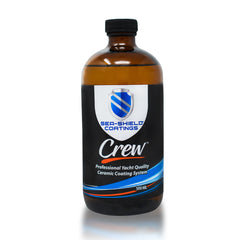 Crew Ceramic Coating
Crew Ceramic Coating
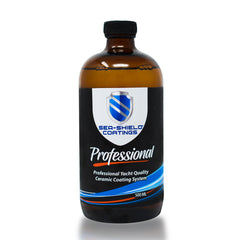 Professional Ceramic Coating
Professional Ceramic Coating
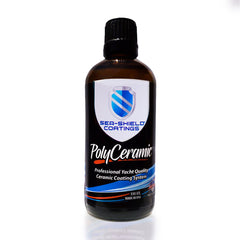 Polyceramic Coating
Polyceramic Coating
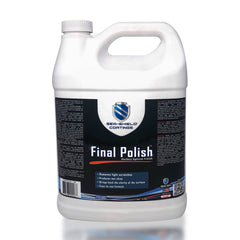 Polishes
Polishes
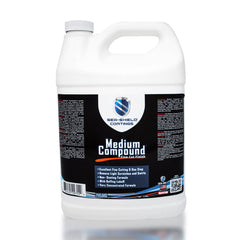 Compounds
Compounds